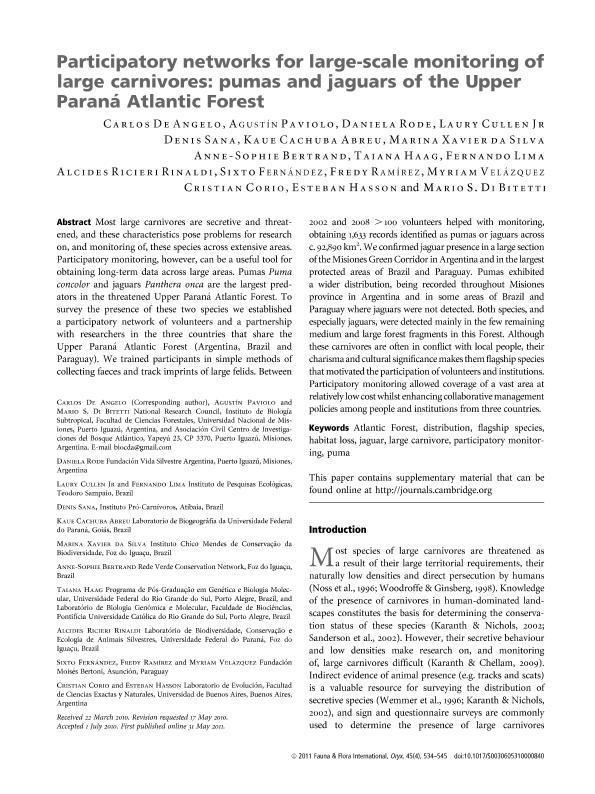Artículo
Participatory networks for large-scale monitoring of large carnivores: Pumas and jaguars of the Upper Paraná atlantic forest
de Angelo, Carlos Daniel ; Paviolo, Agustin Javier
; Paviolo, Agustin Javier ; Rode, Daniela; Cullen, Laury; Sana, Denis; Cachuba Abreu, Kaue; Xavier da Silva, Marina; Bertrand, Anne-Sophie; Haag, Taiana; Lima, Fernando; Ricieri Rinaldi, Alcides; Fernàndez, Sixto; Ramírez, Fredy; Velazquez, Myriam; Corio, Cristian Hernan; Hasson, Esteban Ruben
; Rode, Daniela; Cullen, Laury; Sana, Denis; Cachuba Abreu, Kaue; Xavier da Silva, Marina; Bertrand, Anne-Sophie; Haag, Taiana; Lima, Fernando; Ricieri Rinaldi, Alcides; Fernàndez, Sixto; Ramírez, Fredy; Velazquez, Myriam; Corio, Cristian Hernan; Hasson, Esteban Ruben ; Di Bitetti, Mario Santiago
; Di Bitetti, Mario Santiago
 ; Paviolo, Agustin Javier
; Paviolo, Agustin Javier ; Rode, Daniela; Cullen, Laury; Sana, Denis; Cachuba Abreu, Kaue; Xavier da Silva, Marina; Bertrand, Anne-Sophie; Haag, Taiana; Lima, Fernando; Ricieri Rinaldi, Alcides; Fernàndez, Sixto; Ramírez, Fredy; Velazquez, Myriam; Corio, Cristian Hernan; Hasson, Esteban Ruben
; Rode, Daniela; Cullen, Laury; Sana, Denis; Cachuba Abreu, Kaue; Xavier da Silva, Marina; Bertrand, Anne-Sophie; Haag, Taiana; Lima, Fernando; Ricieri Rinaldi, Alcides; Fernàndez, Sixto; Ramírez, Fredy; Velazquez, Myriam; Corio, Cristian Hernan; Hasson, Esteban Ruben ; Di Bitetti, Mario Santiago
; Di Bitetti, Mario Santiago
Fecha de publicación:
10/2011
Editorial:
Cambridge University Press
Revista:
Oryx
ISSN:
0030-6053
Idioma:
Inglés
Tipo de recurso:
Artículo publicado
Clasificación temática:
Resumen
Most large carnivores are secretive and threatened, and these characteristics pose problems for research on, and monitoring of, these species across extensive areas. Participatory monitoring, however, can be a useful tool for obtaining long-term data across large areas. Pumas Puma concolor and jaguars Panthera onca are the largest predators in the threatened Upper Paraná Atlantic Forest. To survey the presence of these two species we established a participatory network of volunteers and a partnership with researchers in the three countries that share the Upper Paraná Atlantic Forest (Argentina, Brazil and Paraguay). We trained participants in simple methods of collecting faeces and track imprints of large felids. Between 2002 and 2008 > 100 volunteers helped with monitoring, obtaining 1,633 records identified as pumas or jaguars across c. 92,890 km 2. We confirmed jaguar presence in a large section of the Misiones Green Corridor in Argentina and in the largest protected areas of Brazil and Paraguay. Pumas exhibited a wider distribution, being recorded throughout Misiones province in Argentina and in some areas of Brazil and Paraguay where jaguars were not detected. Both species, and especially jaguars, were detected mainly in the few remaining medium and large forest fragments in this Forest. Although these carnivores are often in conflict with local people, their charisma and cultural significance makes them flagship species that motivated the participation of volunteers and institutions. Participatory monitoring allowed coverage of a vast area at relatively low cost whilst enhancing collaborative management policies among people and institutions from three countries.
Archivos asociados
Licencia
Identificadores
Colecciones
Articulos(CCT - NORDESTE)
Articulos de CTRO.CIENTIFICO TECNOL.CONICET - NORDESTE
Articulos de CTRO.CIENTIFICO TECNOL.CONICET - NORDESTE
Citación
de Angelo, Carlos Daniel; Paviolo, Agustin Javier; Rode, Daniela; Cullen, Laury; Sana, Denis; et al.; Participatory networks for large-scale monitoring of large carnivores: Pumas and jaguars of the Upper Paraná atlantic forest; Cambridge University Press; Oryx; 45; 4; 10-2011; 534-545
Compartir
Altmétricas



